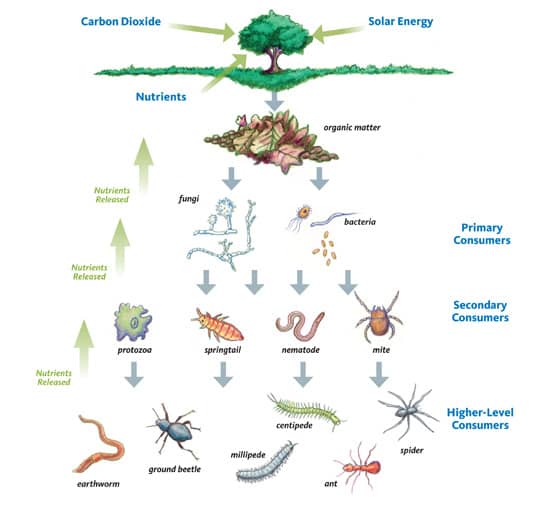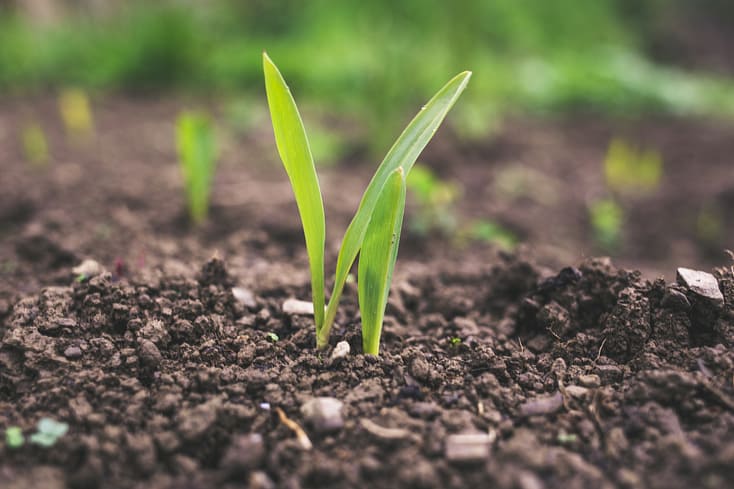Regenerative agriculture is about reimagining our relationship with land.
Let’s start at the bottom: with soil. Soil itself is truly a living entity. Among the clay, sand, and silt particles are the living roots of plants, threads of mycelium, animals like worms and nematodes, and tons and tons of microbes. This dynamic, interconnected community of living things is known as the soil food web. Soil is responsible for providing us with 95% of the food we eat, either directly or indirectly, according to the Food and Agriculture Organization of the United Nations. Healthy soil is defined as having the capacity to function as a living system. Soil also provides us with other services like climate change mitigation/adaptation, water purification, and microbes that help diversify our microbiome and provide us with nutrients as well as microbes that we use to make medicines and technologies.
But our soils are getting tired. Multiple issues with industrial agriculture are leading many to turn towards a nature-based solution. Regenerative agriculture is a principle in which food (or textiles or forestry products) is grown in a way that instead of simply extracting nutrients and life from the soil, actually builds matter and life in the soil. Its benefits are seemingly endless, including improving biodiversity, resilience, and environmental health.

The “Green” Revolution
The Green Revolution was essentially the industrial revolution of biological systems, through which we tried to reduce complex ecosystems into assembly lines for a single cash crop with the aim to increase efficiency and product output. In the short term, fields that received large doses of new fossil fuel-based compounds, called petrochemicals, produced an abundance of a single crop. Large machinery made it easy to maintain big swaths of land. However, the long term effects of applying large amounts of synthetic pesticides and fertilizers have degraded the crucial foundation of agriculture: the soil. The industrialized agricultural system that took root increasingly reduced the amount, structure, and fertility of soil, and eliminated much of the complex soil food web. Because agriculture covers about half of the earth’s ice-free land, it provides one of the greatest potential reservoirs of solutions to transition these farmlands into systems that nurture soil health and regenerate soil fertility.
What does it mean to be regenerative?
Regenerative farming is a system of producing food and biomass that focuses on building functional biodiversity and soil health to produce consistent yields without relying on synthetic inputs (herbicides, pesticides, and chemical fertilizers). Despite growing interest in regenerative agriculture, there is no centralized “official” definition because regenerative agriculture is not a static state. Rather, regenerative agriculture is a journey that involves fundamentally changing our perspectives about nature and agriculture – in short, a shift in our mindset.
Through this lens, we see that regenerative agriculture is a way of moving from that extractive, reductive, and destructive form of agriculture and towards a sort of nutrient equilibrium – balancing multiple symbiotic life forms to create rather than destroy ecosystems.

Humans’ understanding of agricultural effects on soil health has dramatically improved, leading to the realization that monoculture with heavy inputs of pesticide and fertilizer is actually not a best practice in land management and is increasingly disadvantageous. You may fear that moving away from industrial agriculture and towards more regenerative farming in line with nature would lead to lower yields and fail to feed our huge global population. Recent meta analyses have identified that farm yield does not decrease in farms that prioritize biodiversity. Yet, there is a cost and time delay in the conversion of conventional and sustainable farming practices. What indigenous people with traditional knowledge have long known, is that soil fertility and functional biodiversity are the keystones of productive and regenerative farming systems.
Regenerative Farming in Practice
Regenerative farming, or farming in line with nature, also known as restorative agriculture or ecoagriculture, is a nature-based solution, and it is significantly different from organic farming. Organic farming focuses on removing synthetic pesticide inputs or replacing them with organic alternatives in otherwise conventional (often industrial) farming, then farms can be certified as organic. Regenerative farming, which does not have any formal certification, means rethinking the entire farm operation, building functional biodiversity by thinking of the farm as a landscape and building in elements to promote healthy ecosystems. There is no single pathway to regenerative farming. Some practices that you will see on regenerative farms are landscape elements (e.g. hedge rows with multiple species of bushes and shrubs), perennial rather than annual plantings, mulch and green manure covering any bare soil, and trees planted among the crops.
Creating permanent habitats on the farm provides homes for small animals like pollinators and pest predators. This creates a dynamic environment that can respond to stresses and is more resilient thanks to the diverse interlinking aspects of its food web. The same goes for the soil. When tilling is stopped, and the soil has constant vegetation growth, plant roots are able to provide homes to many microorganisms that provide nutrients, and fertility to the soil and the food. Regenerative agriculture is a mindset shift from extractive to restorative practices. It’s important that specific practices aren’t cherry picked but rather a comprehensive farm plan developed for this long term transition.

Five regenerative agriculture practices and their impact on the soil:
1) Cover cropping with green manure
Green manure is plant matter that is grown alongside the primary crop and provides multiple benefits. Not only does the cover crop bring diversity to the field which in turn can bring diverse pollinators and pest predators, but the cover crop is then incorporated back into the soil. This is a very direct way of regenerating soil, providing it with biomass to feed on and build itself up. Adding cover crop as green manure helps to increase the nutrient content of the soil, and the crops you plant and incorporate into the soil can be tailored to the nutrient needs of the soil.
2) Prioritizing perennial plants
Perennial means that the plant and its roots remain in the ground year over year instead of being pulled up after a season. Perennial crops, ground cover, and landscape elements provide a unique function for the soils. Soils are a living entity and roots that continue to inhabit soils year after year engage in more complex, symbiotic relationships with the organisms around them. Helpful fungi latch onto roots and provide communication channels and nutrient exchange for one another, bacteria develop nodules and provide services in the form of enzymatic reactions (i.e. converting nitrogen in the air to nitrogen in the soil), and the positive soil food web impact increase from there.
3) Minimizing/removing tillage
Tilling, or ploughing, soil aerates the upper layer of soil typically 20-50 centimeters in depth. Although in the short term, tilling facilitates easier planting, in the long term there is a critical loss of soil structure. Soil structure helps to retain moisture and allows drainage in the soil. Also, soil structure provides the scaffolding within which the soil food web thrives. Without this structure, there will not be significant life in the soil.
4) Reducing/removing synthetic inputs
Regenerative agriculture does not need to be a zero-input system, but rather a system where there is a net positive gain in soil generation. Pesticides are indiscriminate and kill not only the pest they are aiming at, but also similar organisms removing critical components of the soil food web. Soils become dependent on inputs of synthetic fertilizers and reduce their own capacity to circulate nutrients without these inputs. Slowly reducing synthetic inputs like pesticides and fertilizers allows the natural ecosystem in the soil to flourish.
5) Mulching with organic materials
Studies have shown that there can be incredible biodiversity in leaf litter layers as they slowly break down. Like green manure, mulch provides additional biomass to the soil to facilitate soil regeneration. Mulch also prevents bare soil, which prevents soil erosion

Why are companies transitioning toward regenerative farming?
No matter what product a farmer is producing, be it milk or kale, what regenerative land management systems have in common is that they protect against climate, supply chain, and regulatory risk. Soils are getting tired, and the current (industrial) farming models are not exactly profitable: last year 40% of farmers’ income in the USA came from government subsidies. By contrast, regenerative farming systems require fewer expensive inputs and often produce a wider variety of salable crops and byproducts. Not only is regenerative farming beneficial for increasing biodiversity and (environmental as well as economic) resilience, but the practices can also be used as carbon sinks, sequestering carbon in the soil. Many enterprising farmers are already accessing carbon credit markets by switching to regenerative practices. Moving from conventional agriculture to regenerative agriculture requires a mindset shift, and it is a shift we see happening at all scales all across the globe. The tradeoff in regenerative agriculture is that the systems are more complex to manage, but this does not translate into a reduction in yield. Most importantly, in the transition to regenerative agriculture, the benefits to human and environmental health are profound.
Learn more about Metabolic’s work on Regenerative Agriculture




